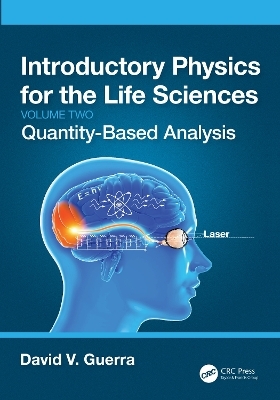
Introductory Physics for the Life Sciences: (Volume 2)
CRC Press (Verlag)
978-1-032-31108-1 (ISBN)
The order of topics studied in this volume requires students to first understand a concept, such as the conservation of energy, momentum, voltage, or current, the change in a quantity such as entropy, or the rules of ray and wave optics. Then, students apply these concepts to solve problems in the areas of thermodynamics, electrical circuit, optics, and atomic and nuclear physics.
Throughout the text these quantity-based applications are used to understand systems that are critical to the understanding of biological systems, such as the entropy of evolution, the signal down the axon of a nerve cell, the optics of the eye, and the operation of a laser.
This is part 2 of a two-volume set; volume 1 introduced students to the methods of mechanics and applied these problem-solving techniques to explicitly biological topics such as the sedimentation rate of red blood cells in haemoglobin, the torques and forces on a bacterium employing a flagellum to propel itself through a viscous fluid, and the terminal velocity of a protein moving in a gel electrophoresis device.
Key features:
Organized and centered around analysis techniques, not traditional mechanics and E&M
Presents a unified approach, in a different order, meaning that the same laboratories, equipment, and demonstrations can be used when teaching the course
Demonstrates to students that the analysis and concepts they are learning are critical to the understanding of biological systems
David Guerra, Ph.D., is a Professor of Physics at Saint Anselm College (SAC), United States of America. During his time at SAC, he has taught many of the courses offered by the department, including the physics course for biology majors, and has developed and taught courses in such topics as laser physics and remote sensing. At SAC, he has conducted remote sensing research, both in instrument development and data analysis. Upon arriving at SAC, Professor Guerra designed, built, and operated a novel lidar (laser radar) that utilized a holographic optical element (hoe) as its transmitter and receiver. This work was done over the course of his first decade at SAC with several sets of student researchers and in coordination and with funding from NASA-Goddard Space Flight Center. The project resulted in a series of publications and the successful development of a lidar system that was flown by NASA using the (hoe) technology. In his time since the successful completion of the lidar work, Professor Guerra has focused his remote sensing research on the analysis of remote sensing data in the investigation of natural systems. As part of a National Science Foundation (NSF) grant, Professor Guerra conducted research with several sets of student researchers and faculty from other universities from across New Hampshire to study the environmental dynamics of the natural systems throughout their state. He continues his collaborative remote sensing work with faculty from the departments of computer science and biology at SAC, investigating relationships between environmental conditions and animal behavior and plant development. Professor Guerra has also done work in physics education research, ranging from the development of new laboratory experiences to new pedagogies and even chapters in a widely used high school physics textbook.
1. Energy and Work. 2. Momentum and Impulse. 3. Angular Momentum and Rotational Kinetic Energy. 4. Temperature and Heat. 5. Thermodynamics of Heat Engines. 6. Thermodynamics - Entropy. 7. Electric Circuits. 8. Capacitance. 9. RC Circuits. 10. Light and Color. 11. Geometric Optics. 12. Physical Optics. 13. Quantum Nature of Matter. 14. Quantum Nature of Light. 15. Nuclear Structure and Radioactivity. Index.
| Erscheinungsdatum | 17.07.2023 |
|---|---|
| Zusatzinfo | 17 Tables, black and white; 240 Line drawings, black and white; 1 Halftones, black and white; 241 Illustrations, black and white |
| Verlagsort | London |
| Sprache | englisch |
| Maße | 178 x 254 mm |
| Gewicht | 530 g |
| Themenwelt | Naturwissenschaften ► Biologie ► Genetik / Molekularbiologie |
| Naturwissenschaften ► Chemie ► Physikalische Chemie | |
| ISBN-10 | 1-032-31108-8 / 1032311088 |
| ISBN-13 | 978-1-032-31108-1 / 9781032311081 |
| Zustand | Neuware |
| Informationen gemäß Produktsicherheitsverordnung (GPSR) | |
| Haben Sie eine Frage zum Produkt? |
aus dem Bereich


